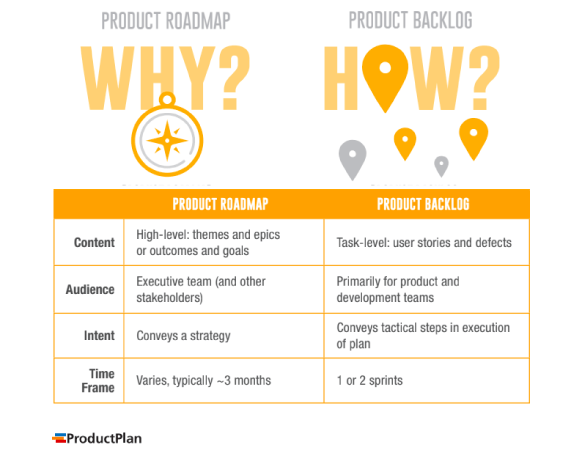What is the Product Backlog?
Definition: A product backlog lists and prioritizes the task-level details required to execute the strategic plan set forth in the roadmap. The backlog should communicate what’s next on the development team’s to-do list as they execute on the roadmap’s big-picture vision. Typical items in a product backlog include user stories, bug fixes, and other tasks.
The backlog is a translation of how your team will deliver the vision outlined on an agile roadmap. In many ways, it is a giant to-do list for your development team.

What Does the Product Backlog Contain?
What belongs in your product backlog? This is a difficult question because the contents of the backlog vary greatly from team to team. In general, the backlog functions as a list of all projects and initiatives related to a product. If you do not include an initiative on the backlog, it will most likely not get done. This means it is home to a variety of different items including (but not limited to):
- New features
- Infrastructure updates
- Changes to existing functionalities
- Bug fixes
- Technical debt and refactoring
In most cases, product managers break down items into user stories. However, not all backlogs talk in user stories. Every team has its own way of structuring the contents in its backlog.

Who Owns the Backlog?
While the entire cross-functional agile team works together on the backlog, the product owner owns it. In most cases, the product owner (or product manager) holds responsibility for organizing and maintaining the product backlog. However, it is general advice to allow various members of the cross-functional team to contribute items to the backlog.
It’s worth noting here that depending on a team’s approach to agile, there may be multiple backlogs with different purposes and owners. In the Scrum methodology, for example, a sprint backlog is owned by the delivery team.

How Do You Manage the Backlog?
Managing the product backlog comes with several different responsibilities and tactics. As the product roadmap is updated often, it needs to be closely connected to the product backlog. So, the backlog needs to be prioritized (and re-prioritized) often to reflect changes and new findings.
Additionally, care should be taken to keep the backlog organized and easy to navigate. Agile best practices suggest striving for a “DEEP product backlog,” where the items slated for the near term have the most detail, and the level of detail decreases with priority.
In addition, most agile teams participate in backlog grooming sessions to refine and order backlog items. During these sessions, the team works together to prepare a few sprints worth of user stories ahead of time. Backlog grooming sessions ensure that the user stories at the top of the backlog contain sufficient detail for the delivery team to understand them.
To learn more about backlog grooming, watch our video.
What is the Difference Between a Product Backlog and Product Roadmap?
Do not confuse the product backlog with a product roadmap. Both of these living documents serve distinct purposes for agile teams. While the backlog lists tactical details of development, the roadmap focuses on the broader strategy. For a more in-depth comparison, read our overview of the product roadmap vs. product backlog.